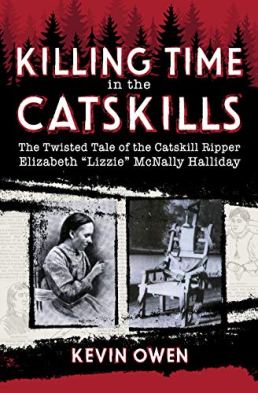 KILLING TIME IN THE CATSKILLS
KILLING TIME IN THE CATSKILLS
The Twisted Tale of the Catskill Ripper:
Elizabeth ‘Lizzie’ McNally Halliday
Kevin Owen
Moonlight Press, 2019
You know how it is being a crime writer: you idly google to find any local crime or interesting murders in the region, so being confined to the Hudson Valley at present I decided to do a little looking around and discovered the tale of Maggie/Lizzie McNally [several other married names] Halliday (or actually Halladay because her last husband’s name was misspelled). Intrigued by the short version of her life and misdeeds, and like so many of us at present far too inclined to use any excuse to get more books, I ordered Owen’s in hopes of getting a lot more useful detail on the intriguing suggestions an internet search brought. She was interviewed by Nellie Bly! What all did they talk about? She was actually Irish: was she really credibly accused of not only being ‘the worst woman on earth’ but also possibly Jack the Ripper?
Owen’s book offers a lot of detail presented in a straight-forward manner, reasonably free of the constant rhetoric deploring the obviously terrible actions which can mar these local histories. Believe me, her actions speak quite plainly for themselves! She may not be the worst woman on earth even in the late 19th century, but she sure caused a lot of mayhem.
Lizzie (or Maggie as she was called by her family then) came over from Co Antrim after her father John and oldest brother Sam got a foothold in the US. The youngest of eight children, at about 8 years of age, Maggie/Lizzie arrived in Newburgh, NY with lots of other Irish immigrants. Like so many of the immigrant women who arrived then, she soon left school and went into service. It didn’t take long to find out that her temper did not suit being a servant. A pattern soon emerged of Lizzie demanding money that she felt she was owed and revenge against anyone who said otherwise.
Lizzie found being a washerwoman offered some measure of independence in comparison to being a servant in a fine house, where her last job ended when she threatened a child with a knife. As Owen points out, there wouldn’t be much record of her early life ‘if not for her outbursts of violent temper and threats to others’ (19). At fifteen she marries for the first time one of her washing clients, Charles Hopkins — who of course is not really who he says he is but Keetspool Brown, a deserter from the British Army. Oh and he’s still involved with a married housekeeper — who’s soon found dead. Was it suicide? Was it Charles/Keetspool? Was it Lizzie? Did her murderous career begin here?
She has a child with her first husband — a son who will eventually be taken away from her for his safety. His fate is unknown. Also the cause of death of her first husband was unclear: typhoid? Too long inhaling bristles from the brush factory he worked in? Or maybe poison? She claimed it wasn’t her: husband number two — much older and with a good pension and an opium habit, that was much more likely to be Lizzie’s plan. The third husband lost all his money but managed not to lose his life. The fourth survived some poisoned tea. The fifth was the first to be almost as young as she, but soon disappeared. For a time Lizzie took to ‘tramping’ (hobo life) and sometimes living with the Travellers who had come to that region.
Things go on all the way to her last fatal husband and a curious double homicide that may have had something to do with revenge. The murders were a sensation — her capture and trial even more so. Women who murdered tended to be more genteel: the brutal and contemptuous manner of her final spree shocked the nation.
And it didn’t all end there!
Well worth a read. A few quibbles: not once was Antrim spelled correctly; the page layout is a bit wonky but you get used to it. Because part of my interest was wanting to dive into the primary materials I found the bibliography a confusing mess. With no footnotes or endnotes, it is doubly vexing to have no discernible order to the works cited nor connection to the information in the text.
By the way, no: no credible chance of her being linked to the Whitechapel murders.
